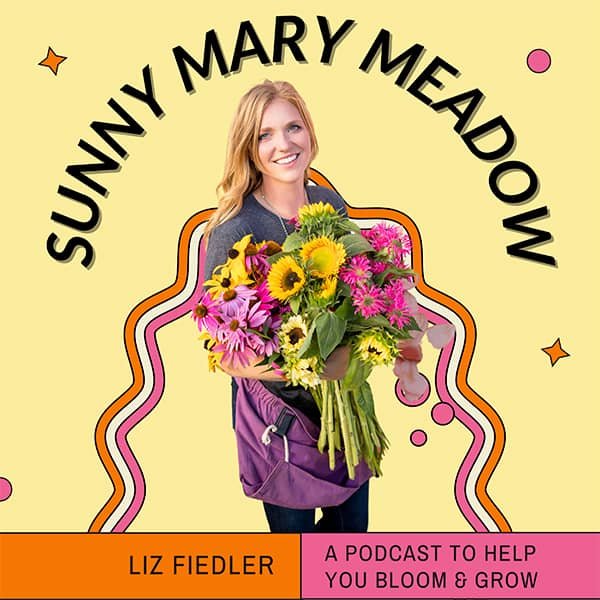
Welcome back to another episode/post of the Sunny Mary Meadow podcast/blog. Today, we’re going to talk about harvesting cut flowers. First, we’re going to start off with a little science lesson, and then I promise we’re going to cover so many things within this one little topic.
So, a plant reproduces by creating a flower, then pollinating, then the flower fades, then the seeds begin to grow, and then they spread out to produce a new plant. So, it sounds cruel, but our job is to cut it before it has the chance to reproduce. A lot of flowers are cut in different ways and stages. Ultimately, it’s a lot of trial and error, and it’s a skill that comes with experience.

One of the things that you have to keep in mind is time of day. Most flowers are going to be most turgid in the morning (filled with water). You want to cut them when they’re not dehydrated and they’re going to have the most water in the morning. This means they’re going to have less wilt, and they’re gonna look fresher. However, in the evening (I did a little reading on this), the stems have been photosynthesizing all day, and they contain more carbohydrates. Which actually gives them a longer vase life. So, if you cut them in the morning, it reduces wilting. If you catch them in the evening, they have a longer vase life. So, either way, whether you cut in the morning or evening, you’ll be good. However, you shouldn’t cut in the peak of the day and, ideally, in a perfect world if it’s 80 degrees or less. And there’s a short window because even if you do it right away in the morning, you have to do it after the dew has dried. If you cut flowers with a ton of dew on them, they can get moldy, and they can get diseases. But you also want to cut them before it gets too hot.
That being said, there are some July evenings where the temperature does not start reducing until 8:00 pm, so there’s really this small window to harvest them. There are a couple of options when this happens – I have never actually used this, but there are some hydration solutions that you can use to make them absorb more water if you pick them during the heat of the day. Again, I’ve never used them. But I would imagine places like California, or in the south, pretty much have no choice but to use them. Whereas in Minnesota, we get a couple-hour window in the morning and a couple-hour window in the evening, except for those hottest days of the summer, so it’s really not that big of a problem here. I personally like cutting in the evening because then they can sit all night in buckets, and then I make the bouquets first thing in the morning. I’m an early riser, I get up at 5:00 am, so I can start making bouquets right away in the morning. Then, by the time I’m done and need more flowers, the dew has dried. So that’s why I like to harvest at night so that I can just let them sit all night and soak up that water. In the summertime, every Wednesday and every Friday, we make 50 bouquets here on the farm. So, it’s nice to pick flowers on Tuesday night and then make the bouquets right away Wednesday morning … or at least pick for half of them and make half of the bouquets right away in the morning and then pick for a while in the morning because people aren’t going to pick them up till later. For my subscriptions, customers can pick them up anywhere from 9:00 am until dark. They just come at their convenience and sign their name on the list. There are 50 people, and I know who they all are. It’s a small town/small area, so when they’re just coming and going, it’s fine. I recognize every vehicle, and we’re good to go.
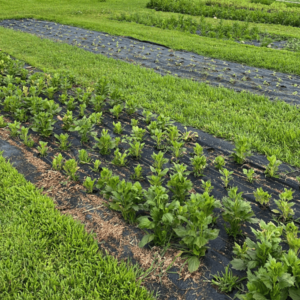
They don’t all come at once, so they’re not all showing up at 9:00 am. Some of them aren’t coming until 4:00 pm in the afternoon. So, I can pick flowers the night before and make the bouquets for the morning pick-ups and then start picking at 8:00 am or 9:00 am and make the bouquets in the early afternoon for the last 20 or so that will come later. I’ve just learned people’s behaviors and when they come. Some people are like, “Hey, heads up. I know I’m a Wednesday, but there’s a lot going on. And there are maybe 10ish people that are like, I’m not going to come till Thursday morning because I can’t come after work, so I’ll just come at 8:00 am on Thursday, knowing that it would be too late Wednesday. If that ends up happening, it’s okay, I’m just going to make 10 bouquets on Wednesday night, and then they will be fresh for them Thursday morning. We get in a groove, we figure it out. As far as picking, it’s kind of one of those things where you pick whenever your preference is – morning or evening.
The next thing we will talk about is the cleanliness of your buckets and scissors/shears. I will be the first to admit that any of my volunteers, or people that have worked here, will be like, “That’s BS. She doesn’t sanitize her buckets and scissors.” Well, yeah, I haven’t been great about it, but going forward, I’m going to be better about it, okay? We’re going to start sanitizing twice a week. I’ve already talked to Lindsay, who works here, and a couple of my main volunteers, and said, “All right, guys, every Monday and Thursday, we are sanitizing. That’s just the way it is. We’re gonna have to do it regularly and not just when we think of it because it really does make a difference.” Bacteria can plug up the bottom of stems, and then they can’t soak up as much water, so it really can affect the vase’s life.
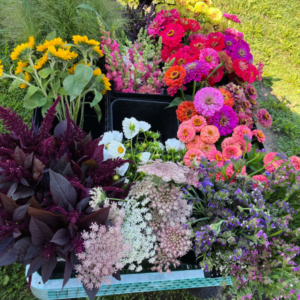
There’s a couple of different ways to clean them. The first is that you can just do a few drops of liquid detergent and a few drops of bleach … and actually, even certified organic farms can use some bleach for cleaning purposes. The other option is using hydrogen peroxide. Keeping your scissors/shears and buckets as sanitized and clean as possible is so important. I fill the buckets with a couple of inches of warm soapy water and brush them out with a long-handled bristle brush, and then just pour that water into the next bucket, and so on. I keep going down the line until the water comes out not soapy and not dirty. And, like I said, add a couple of drops of bleach, and you’re good to go there.
It’s also important to have not only a clean bucket and clean scissors/shears but also sharp scissors/shears. You can really waste a lot of time by not having sharp, ready-to-go scissors/shears. I also try my best to have buckets of the right sizes. It depends on what I have going on – if I’m just picking flowers for myself to make bouquets for subscriptions, it doesn’t really matter if they’re the Menards buckets, or a bucket from the hardware store, or a bucket that used to have paint in it and have cleaned out (a five-gallon plastic bucket), that’s fine. But if I know that I’m going to be using them at my stem bars, where people build their own bouquets, I use some really nice three-gallon black square or rectangle buckets. For those events, I try to just harvest them directly into those nicer buckets because why sort/move them later? I just try to eliminate that step of having to move them. You also can use galvanized metal buckets, but most people will use a plastic liner for the inside of those to reduce rust.

When it comes to picking flowers, it’s a skill that comes with experience. It’s a whole lot of trial and quite a bit of error. I try to think of flowers as a medium. One of my best friends, Tammy, is this awesome cake decorator, and she was teaching me how to decorate cakes. She said, “You have to think of the frosting as a medium. It’s not food, it’s a medium. Don’t worry about wasting it. Don’t worry about coloring it the wrong way. Don’t worry about saving some. It’s just used to decorate your cake.” And that’s kind of how you have to think about flowers, too. Do not try to focus on the value of every single stem, or you’re gonna go crazy. If you’re harvesting them and trying to count your chickens before they hatch, you think, “Okay, well, if I’m selling these sunflowers at this much a bunch, it’ll be this much.” Nope. Don’t do that. You know how many you planted, so plan for a 20% loss between germination, harvesting, stems getting bent in the buckets, etc. You cannot treat them each like their own little delicate stem when you’re harvesting them. Save as many as you can but try not to think about it as “these are each $1 a stem,” because otherwise, it’s too much to try to focus on. Even when I buy them wholesale in the off-season for things like Valentine’s Day, I always buy 10% extra, even though I usually have very good luck with my wholesaler. But obviously, you can’t assume. For example, if I’m making 12 bouquets and they’re each gonna have two tulips, I need 24 tulips, but it doesn’t work to order the exact amount you need. You need to round up. More is better because you’re going to have some that break off. Especially if I’m working with snapdragons or some of those flowers like that, for the most part, I would say 90% turn out great.
So when you cut the flower, I want you to take your non-dominant hand to grab the base of the stem, and you’re going to cut it low for the most part (almost all of the flowers you’re going to cut low). Then you’re going to use your dominant hand to cut it. Now you take the flower, flip it over upside down, and then strip the foliage down from the lower end of the stem. And when I say that, I mean all of the leaves. Take the snapdragon, for example … you’re going to want to remove all of the leaves that are going to be below the waterline. If you use mason jars like me, that’s the majority of the leaves of the stem. Don’t do that directly onto the ground or onto the grass, because then you’re gonna have this huge pile of decaying rotting leaves, and it’s going to harbor bacteria, there’s gonna be a bunch of insects, you may get a mouse nest in there if your pile gets too big, etc. Just put it into a bucket. I have designated compost buckets, and all I do with them is collect leaves in them, and then I dump them on the compost pile. I never put water in them because, remember, we talked about bacteria. That’s all they’re used for, is for those extra leaves.

Depending on which way the leaves go, take your thumb and index finger down the stem and just strip the leaves into a bucket. You’ll want to do this in the field/garden, not in your workspace because if you make bouquets in your kitchen, you don’t want all those leaves there. Or even if you make them in a dedicated workspace, do it that way anyway to keep your space cleaner. The reason I say to hold it that way, specifically, is because I can get at least a bunch of 10 stems in my hand (depending on the kind of flower) before I stop to go put them in the bucket. Zinnias are kind of hard because they bunch together, and then the leaves can damage each other. But like snapdragons, statice, and cosmos, I can get a good 10 flowers in my hand before I have to pause and go to the bucket. This is also nice because I am actually starting to sell some bunches to a wholesaler this summer, and they want them in 10-stem bunches. So, if I can get them all bunched together in groups of 10 while still in the field and know that there were exactly 10 in my hand, even if I don’t get them rubber-banded or fastened together while I’m in the field, I know that there’s exactly 40 stems in that bucket and we’re good to go. It’s gonna save me time later.

I will shift the stems to my pinky and ring finger, my ring finger and middle finger, and literally hold them together. I’ll pick them, I’ll hold them between my thumb and forefinger and my thumb and middle finger, strip the leaves, and then shift them to the spaces between my other two fingers. Then I can get 10 of them in my hand at a time before I have to stop and put them in a bucket. This is especially important when it’s a way bigger flower field than mine. Again, I don’t have this problem, but if fields are growing for a wholesaler, they’ll bunch them in groups of 10, and then they literally have people designated to wrap them in 10 stem bunches right in the field, bring them to water so that they’re in the shade, and just preserve them. It isn’t die-hard that I go that quickly like that, but if I can harvest faster and take a half-hour off of my morning, that’s fantastic. Again, if I’m doing 50 bouquets a couple of times a week for subscriptions, not including the stem bar, maybe there’s 12 per bouquet, which ends up being 600 stems that I have to harvest. That’s a lot, and that can take a lot of time. For example, usually, it’s two snapdragons per bouquet, so that’s 100 snapdragons I need to pick, and I know I need that many, so I’ll pick 110 or whatever it ends up being to have some extras.
As I said, some flower farmers will have assistants or bucket runners to go back and forth. So it depends if you’re making bouquets or selling bunches to a wholesaler. If you are making bouquets, knowing exactly how many you have is not as necessary. But as I said, if you’re doing stem bunches, if you can do bunches of 10 right in the field or know there’s exactly increments of 10 in those buckets, that just makes it go way faster. For example – if there are 40 stems in a bucket and you count 10, count 10, count 10, you don’t have to count the last 10 because you already know that’s what’s there.

Also, I did this a few times last year, but it wasn’t quite as necessary because I wasn’t selling at the quantity I am this year … I’m going to do my best to label buckets with the quantity in them before I put them in the cooler. I don’t want to just use a post-it because the humidity will make it not stick. Again, inside our coolers, it’s at least 80% humidity, which is the goal in a flower cooler. I have these long metal sticks for labeling my stem bars, and I’ll just put a piece of paper on there that says whatever the number of stems ends up being. I’ll try to have them be in increments of 10, ideally, but that won’t always work.
Sometimes I’ll change out the water that’s in the buckets in the cooler, but that’s not always necessary. It just depends. Sunflowers and zinnias are pretty dirty flowers, and they can make the water a little bit cloudy, a little bit murky. It also kind of depends on things like if it rained recently, if the stems are slightly dirty, if the water is getting dirty, if the flowers are dirty if it’s been really dusty, etc. Depending on these things, I change it out once I get back to the shop before I put it in the cooler.

Like I’ve talked about before, I have a walk-in cooler from the butcher shop that used to run here at the farm in about the 1960s. I have no idea what brand it is or anything like that, but it used to be used as a meat cooler. The temperature in there is consistently 38 degrees. Always 38 degrees. Ideally, for flowers, it should be 35 or 36 with at least 80% humidity, but it works great for what I need. I cannot imagine buying a brand-new walk-in cooler for a flower farm, unless you’re really industrial and are selling wholesale and absolutely need it. The wholesaler whom I’m going to be selling 10-stem bunches of lisianthus this summer will actually pick up every night in the middle of the night. So that’s very ideal because then I don’t need to store them for three or four days. If you’re doing things on a smaller scale and are looking for a cooler, try to keep your eye out for any florists or restaurants going out of business and try to buy a used one. However, if you are going to be selling commercially and are really doing this on a large scale, I would highly recommend buying a specific floral one because it’s going to be the exact same temperature and humidity that you’re going to need to be at consistently.
For those 10-stem bunches, I bought a stem cutter a couple of weeks before my season started. Here is the link for the exact stem cutter that I use, the Larsilk Fresh Flower Stem Cutter. The stem cutter is basically like the old-school paper cutters. My school growing up, would have these stacks of cardboard, and then they would make them into sheets that were like 8 x 11. So, for the stem cutter, I have it screwed onto a wooden cutting board, and I get all the flowers lined up on the left-hand side so they’re all the same length. Then I can see exactly what the length I need is. For example, with the lisianthus, I have all the flower stem heads lined up on the left and then I know it’s exactly 16 inches, and then I just whack it. One big swipe with the cutter does it rather than cutting the bunch by hand with the scissors. I’m really excited about making big bulky bunches that way and being able to cut them off. Most of the bouquets that I make, I make in my hand. So, after I put them together in my hand, I can just take that bunch and cut them off. Lindsay and I have already predicted how long it’s going to take one of us to lose a finger. We were guessing maybe two weeks. We’ll see. No, safety first. We’re going to be careful. I won’t make her finish her shift if she does that. No, I’m just kidding… jokes, jokes. Of course, I’d let her go to the urgent care and get her fingers sewn back on … anyway.

Abbey: I feel like we needed to clarify things. OSHA’s a concern I’m guessing.
Liz: We’re joking. Take a joke.
Abbey: Band-aids will be available. You’re a nurse …
Liz: Yes, I can do stitches. So anyway, that’s our big cutter.
Another thing that I want to talk about is that I know there are a lot of other flower farmers that have made their own walk-in cooler. And that’s definitely the route I would have gone had I not had one available to me, literally sitting in my butcher shop. There’s a brand called Coolbot (C-O-O-L-B-O-T), and it literally enables a window air conditioner to cool down to 35 degrees. So you can take an insulated box or a corner of an existing building, insulate it really well, and turn that into a flower cooler. I know one flower farmer that literally just built a little room within the garage of their house, and either her garage is her floral studio or she makes her bouquets in her kitchen.
I think my fiance would divorce me before we’re married if I made 50 bouquets a day in my kitchen, which is why we’re remodeling the butcher shop. I don’t want them in here, either. I don’t want to look at them all the time, and I don’t want to have that mess to clean up. For me, overlapping the workspace and my house is not a long-term plan. It’s one thing to do it during the winter for Valentine’s Day or something like that when it’s cold out, and it’s fun because I miss flowers. But if my flowers overtook my house during the regular busy season, for those 18 weeks of the year, it just would not go well.
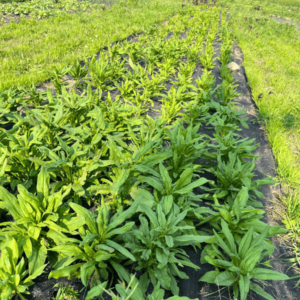
So now I’m going to talk about just a few individual flowers and their specifics. This is not a comprehensive list by any means, but I want to cover a couple of different things. As I said, it’s a lot of trial and error and practicing.
- Zinnias are a flower that has to be fully opened, but if they start pollinating (you can tell they’ve started creating seeds), it’s too far gone. The vases are not going to last very long. To determine if they are ready to pick, you wiggle them back and forth (it’s called the wiggle test), and if their stem is pretty floppy, it’s going to wilt right away in the vase. So, you want them to be stiffer and fully open with zinnias.
- With lilies, when the first two buds are swollen and colored but not open, that’s when you want to harvest them.
- Peonies, you want to cut at the marshmallow stage. They’re still in their bud, but they’re just barely a soft marshmallow when you slightly squeeze them. They haven’t opened yet. I did a whole episode on peonies with more info. But if you do cut them at this stage, they say you can actually store them in the cooler for a couple of months. I’ve done it a month before, and it works. When you take them out of the cooler, you cut off a little bit, put them in water, and they open right up.
- Lisianthus has a stem that has like eight buds on it. The very first one opens on its own. So, you let that one open, and you can either cut it off or just let it be open. Then you wait until the next three-ish have opened, and then you cut the stem. So, the rest of them aren’t going to open, but at least you’ll have three, and then you’re just going to cut that first bloom off. Some people will go through and remove that first bloom in the field so that they can know to wait till the three others bloom before cutting. But to me, that seems like a gigantic waste of time unless I can frolic in my fields at night with a Summer Shandy and cut off that first lisianthus bloom. I say to just let it open, and then as I’m harvesting or arranging or whatever, cut it off later.
- Some of the spike flowers, like delphinium, larkspur, snapdragons, and gladiolus, actually open from the bottom to the top. So it’s this whole long spike of flowers along the stem, and you harvest when the bottom third of the lower flowers are open. They will continue to open up in the vase. The very tips of them aren’t going to open, but the lower buds continue opening as they’re in the vase.
- Some flowers like sunflowers, rudbeckia, and cosmos you harvest when the petals are barely opening and just barely lifting off the center, but they’re not fully open yet. Otherwise, that’s going to be too late.
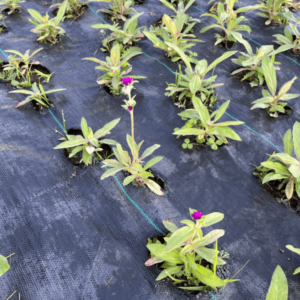
Again, there are so many of these flowers that you just have to learn by trial and error. I could sit here and make a whole list out of them … static – you wait until they’re fully open, dahlias – they’re not going to open anymore when they’re in the vase, basil – you have to harvest it into hot water, and you gotta wait till they’re woody. There are just so many to talk about.
For all of them, you need clean water and clean buckets, you should remove the leaves in the field because you don’t want a bunch of leaves underneath the waterline, you should get them in water as soon as you can but don’t want to run to the bucket every single time, or that’s gonna take too long. So, it’s just a process of figuring out what works for you on your farm.
Abbey, any questions?
Abbey: First question – What is your favorite brand of scissors?
Liz: I can’t think what it’s called. They’re blue. Let me see. The brand is called Growneer. Or I also like Vivosun. Those are the ones that I buy. In fact, I’ll buy another 20 of them for people to cut with at our you-picks. They’re not great for things like sunflowers or more woody plants. For those, I want more of a Fiskars pruning shears. They work better for stuff that’s woodier. But if it’s just regular garden stems, Growneer and Vivosun sheers are my go-tos.
Abbey: Okay, next question – What was the hardest flower for you to learn how to harvest? What gave you the most trouble?
Liz: Honestly, I wouldn’t say any of them gave me trouble other than just having to memorize the info about them. I would look them up on my phone and be like, “Oh, yeah, these are this, these are these … but I think that’s the reason why I don’t recommend growing 20 different types in your first season. Start with five or six, then the next year add five, and then the next year add five. Last year I added 20 things, and I had gomphrena that was wilting. I had orlaya with side stems (for some types, the stems are great, and for some of them, the side stems wilt, and you have to just pick those off), and it’s all just trial and error. There hasn’t been one particularly hard one to highlight, but there have been a lot of difficult ones, and those difficulties have come when I’ve tried to add too many new ones at once.
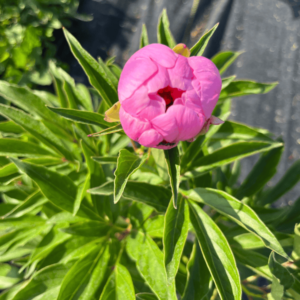
Abbey: Okay, the last thing is that I found a definition for turgid (T-U-R-G-I-D). It refers to cells or tissues that are swollen from water uptake.
Liz: Yeah, it’s also a term we use in the medical field also. There’s also a term “tenting” that we often use for older people, where they’re so dehydrated that if you were to pinch with your thumb and forefinger, their skin just doesn’t go back into place, like on their neck or their arm.
Abbey: Oh … that sounds wonderful.
Liz: Yeah, yeah. It’s just about cells being hydrated.
Abbey: Okay, that’s all I got.
Liz: All right, that’s where we are on harvesting. Again. If you have any questions, email us at podcast@sunnymarymeadow.com. We really do like to know when you’re listening to the podcast or reading the blog. You can also send me a DM on Instagram. Take a screenshot of the episode you’re listening to or reading, and tag me in the post. I do want to know who’s listening … you know, other than just my mom and my neighbor.
Abbey: Take a picture of something that looks turgid to you and tag us in it.
Liz: Yeah, tag us in your turgid photo. (laughing) … Anyway, okay.
Thanks for reading the Sunny Mary Meadow blog. If you like what you’re reading, please subscribe to the podcast and rate us. You can also find us on Instagram, Pinterest, and Facebook.
You can subscribe to our email newsletter below. We love to hear any podcast-related feedback at our email podcast@sunnymarymeadow.com, and all other inquiries can be sent to liz@sunnymarymeadow.com.
